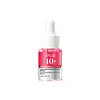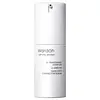Anua Niacinamide 10% + TXA 3% Serum Versus Wardah Crystal Secret 3% Tranexamic Complex + Alpha Arbutin Dark Spot Corrector Serum
What's inside
What's inside
 Key Ingredients
Key Ingredients

 Benefits
Benefits

 Concerns
Concerns

 Ingredients Side-by-side
Ingredients Side-by-side

Water
Skin ConditioningGlycerin
HumectantNiacinamide
SmoothingMethylpropanediol
SolventTranexamic Acid
Astringent1,2-Hexanediol
Skin ConditioningArbutin
AntioxidantSodium Hyaluronate
HumectantXanthan Gum
EmulsifyingEthylhexylglycerin
Skin ConditioningCarbomer
Emulsion StabilisingPotentilla Anserina Extract
Skin ConditioningAmmonium Acryloyldimethyltaurate/Vp Copolymer
Adenosine
Skin ConditioningTromethamine
BufferingPolyquaternium-51
Skin ConditioningAvena Sativa Kernel Extract
AbrasiveCynara Scolymus Leaf Extract
Skin ConditioningBeta-Glucan
Skin ConditioningHydrogenated Lecithin
EmulsifyingCamellia Sinensis Leaf Water
MaskingDisodium EDTA
Alpha-Arbutin
AntioxidantCyanocobalamin
Skin ConditioningLactococcus Ferment Lysate
Skin ConditioningFructooligosaccharides
HumectantButylene Glycol
HumectantCentella Asiatica Extract
CleansingCyperus Rotundus Root Extract
Skin ConditioningTocopherol
AntioxidantMelaleuca Alternifolia Leaf Extract
PerfumingSodium Chloride
MaskingPropanediol
SolventDimethylsilanol Hyaluronate
HumectantHydrolyzed Hyaluronic Acid
HumectantHydrolyzed Sodium Hyaluronate
Skin ConditioningHyaluronic Acid
HumectantPotassium Hyaluronate
Skin ConditioningCeramide NP
Skin ConditioningSodium Hyaluronate Crosspolymer
HumectantHydroxypropyltrimonium Hyaluronate
Sodium Hyaluronate Dimethylsilanol
HumectantSodium Acetylated Hyaluronate
HumectantSucrose Distearate
EmollientCaprylic/Capric Triglyceride
MaskingHydroxypropyl Cyclodextrin
MaskingCentella Asiatica Leaf Extract
Skin ConditioningSaccharomyces Ferment
Skin ConditioningCentella Asiatica Root Extract
Skin ConditioningAsiaticoside
AntioxidantMadecassoside
AntioxidantMadecassic Acid
Skin ConditioningAsiatic Acid
Skin ConditioningWater, Glycerin, Niacinamide, Methylpropanediol, Tranexamic Acid, 1,2-Hexanediol, Arbutin, Sodium Hyaluronate, Xanthan Gum, Ethylhexylglycerin, Carbomer, Potentilla Anserina Extract, Ammonium Acryloyldimethyltaurate/Vp Copolymer, Adenosine, Tromethamine, Polyquaternium-51, Avena Sativa Kernel Extract, Cynara Scolymus Leaf Extract, Beta-Glucan, Hydrogenated Lecithin, Camellia Sinensis Leaf Water, Disodium EDTA, Alpha-Arbutin, Cyanocobalamin, Lactococcus Ferment Lysate, Fructooligosaccharides, Butylene Glycol, Centella Asiatica Extract, Cyperus Rotundus Root Extract, Tocopherol, Melaleuca Alternifolia Leaf Extract, Sodium Chloride, Propanediol, Dimethylsilanol Hyaluronate, Hydrolyzed Hyaluronic Acid, Hydrolyzed Sodium Hyaluronate, Hyaluronic Acid, Potassium Hyaluronate, Ceramide NP, Sodium Hyaluronate Crosspolymer, Hydroxypropyltrimonium Hyaluronate, Sodium Hyaluronate Dimethylsilanol, Sodium Acetylated Hyaluronate, Sucrose Distearate, Caprylic/Capric Triglyceride, Hydroxypropyl Cyclodextrin, Centella Asiatica Leaf Extract, Saccharomyces Ferment, Centella Asiatica Root Extract, Asiaticoside, Madecassoside, Madecassic Acid, Asiatic Acid
Water
Skin ConditioningGlycerin
HumectantCyclopentasiloxane
EmollientNiacinamide
SmoothingDimethicone
EmollientButylene Glycol
HumectantAluminum Starch Octenylsuccinate
AbsorbentPentylene Glycol
Skin ConditioningTrehalose
HumectantHydroxyethyl Acrylate/Sodium Acryloyldimethyl Taurate Copolymer
Emulsion StabilisingPolymethyl Methacrylate
Phenoxyethanol
PreservativeCetearyl Dimethicone Crosspolymer
Bisabolol
MaskingChlorphenesin
AntimicrobialGlyceryl Polyacrylate
Disodium EDTA
Sodium Hydroxide
BufferingParfum
Masking1,2-Hexanediol
Skin ConditioningCaprylyl Glycol
EmollientTranexamoyl Dipeptide-23
BleachingAlpha-Arbutin
AntioxidantLeontopodium Alpinum Extract
Skin ConditioningCitric Acid
BufferingPotassium Sorbate
PreservativeSodium Benzoate
MaskingWater, Glycerin, Cyclopentasiloxane, Niacinamide, Dimethicone, Butylene Glycol, Aluminum Starch Octenylsuccinate, Pentylene Glycol, Trehalose, Hydroxyethyl Acrylate/Sodium Acryloyldimethyl Taurate Copolymer, Polymethyl Methacrylate, Phenoxyethanol, Cetearyl Dimethicone Crosspolymer, Bisabolol, Chlorphenesin, Glyceryl Polyacrylate, Disodium EDTA, Sodium Hydroxide, Parfum, 1,2-Hexanediol, Caprylyl Glycol, Tranexamoyl Dipeptide-23, Alpha-Arbutin, Leontopodium Alpinum Extract, Citric Acid, Potassium Sorbate, Sodium Benzoate
Ingredients Explained
These ingredients are found in both products.
Ingredients higher up in an ingredient list are typically present in a larger amount.
1,2-Hexanediol is a synthetic liquid and another multi-functional powerhouse.
It is a:
- Humectant, drawing moisture into the skin
- Emollient, helping to soften skin
- Solvent, dispersing and stabilizing formulas
- Preservative booster, enhancing the antimicrobial activity of other preservatives
Alpha-Arbutin is made from hydroquinone and glucose. It may also be derived from the fermentation of soybeans.
This ingredient an antioxidant, meaning it helps protect your skin cells against damage.
Studies show this ingredient helps improve hyperpigmentation and fade discoloration.
Alpha-Arbutin may be used with other ingredients that help with hyperpigmentation. These ingredients include retinol, Vitamin C, niacinamide, and tranexamic acid.
Learn more about Alpha-ArbutinButylene Glycol (or BG) is used within cosmetic products for a few different reasons:
Overall, Butylene Glycol is a safe and well-rounded ingredient that works well with other ingredients.
Though this ingredient works well with most skin types, some people with sensitive skin may experience a reaction such as allergic rashes, closed comedones, or itchiness.
Learn more about Butylene GlycolDisodium EDTA plays a role in making products more stable by aiding other preservatives.
It is a chelating agent, meaning it neutralizes metal ions that may be found in a product.
Disodium EDTA is a salt of edetic acid and is found to be safe in cosmetic ingredients.
Learn more about Disodium EDTAGlycerin is already naturally found in your skin. It helps moisturize and protect your skin.
A study from 2016 found glycerin to be more effective as a humectant than AHAs and hyaluronic acid.
As a humectant, it helps the skin stay hydrated by pulling moisture to your skin. The low molecular weight of glycerin allows it to pull moisture into the deeper layers of your skin.
Hydrated skin improves your skin barrier; Your skin barrier helps protect against irritants and bacteria.
Glycerin has also been found to have antimicrobial and antiviral properties. Due to these properties, glycerin is often used in wound and burn treatments.
In cosmetics, glycerin is usually derived from plants such as soybean or palm. However, it can also be sourced from animals, such as tallow or animal fat.
This ingredient is organic, colorless, odorless, and non-toxic.
Glycerin is the name for this ingredient in American English. British English uses Glycerol/Glycerine.
Learn more about GlycerinNiacinamide is a multitasking form of vitamin B3 that strengthens the skin barrier, reduces pores and dark spots, regulates oil, and improves signs of aging.
And the best part? It's gentle and well-tolerated by most skin types, including sensitive and reactive skin.
You might have heard of "niacin flush", or the reddening of skin that causes itchiness. Niacinamide has not been found to cause this.
In very rare cases, some individuals may not be able to tolerate niacinamide at all or experience an allergic reaction to it.
If you are experiencing flaking, irritation, and dryness with this ingredient, be sure to double check all your products as this ingredient can be found in all categories of skincare.
When incorporating niacinamide into your routine, look out for concentration amounts. Typically, 5% niacinamide provides benefits such as fading dark spots. However, if you have sensitive skin, it is better to begin with a smaller concentration.
When you apply niacinamide to your skin, your body converts it into nicotinamide adenine dinucleotide (NAD). NAD is an essential coenzyme that is already found in your cells as "fuel" and powers countless biological processes.
In your skin, NAD helps repair cell damage, produce new healthy cells, support collagen production, strengthen the skin barrier, and fight environmental stressors (like UV and pollution).
Our natural NAD levels start to decline with age, leading to slower skin repair, visible aging, and a weaker skin barrier. By providing your skin niacinamide, you're recharging your skin's NAD levels. This leads to stronger, healthier, and younger looking skin.
Another name for vitamin B3 is nicotinamide. This vitamin is water-soluble and our bodies don't store it. We obtain Vitamin B3 from either food or skincare. Meat, fish, wheat, yeast, and leafy greens contain vitamin B3.
The type of niacinamide used in skincare is synthetically created.
Learn more about NiacinamideWater. It's the most common cosmetic ingredient of all. You'll usually see it at the top of ingredient lists, meaning that it makes up the largest part of the product.
So why is it so popular? Water most often acts as a solvent - this means that it helps dissolve other ingredients into the formulation.
You'll also recognize water as that liquid we all need to stay alive. If you see this, drink a glass of water. Stay hydrated!
Learn more about Water